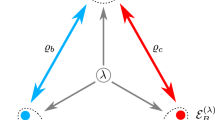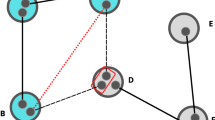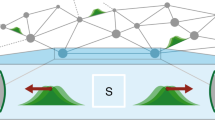Abstract
Quantum mechanics offers new possibilities to process and transmit information. In recent years, algorithms and cryptographic protocols exploiting the superposition principle and the existence of entangled states have been designed. They should allow us to realize communication and computational tasks that outperform any classical strategy. Here we show that quantum mechanics also provides fresh perspectives in the field of random networks. Already the simplest model of a classical random graph changes markedly when extended to the quantum case, where we obtain a distinct behaviour of the critical probabilities at which different subgraphs appear. In particular, in a network of N nodes, any quantum subgraph can be generated by local operations and classical communication if the entanglement between pairs of nodes scales as N−2. This result also opens up new vistas in the domain of quantum networks and their applications.
This is a preview of subscription content, access via your institution
Access options
Subscribe to this journal
Receive 12 print issues and online access
$209.00 per year
only $17.42 per issue
Buy this article
- Purchase on Springer Link
- Instant access to full article PDF
Prices may be subject to local taxes which are calculated during checkout





Similar content being viewed by others
References
Kimble, H. J. The quantum Internet. Nature 453, 1023–1030 (2008).
Gisin, N. & Thew, R. Quantum communication. Nature Photon. 1, 165–171 (2007).
Bennett, C. H. & Brassard, G. in Proc. IEEE Int. Conf. on Computers, Systems and Signal Processing 175–179 (IEEE, 1984).
Perseguers, S. Entanglement Distribution in Quantum Networks. PhD thesis, Technische Univ. München (2010).
Bennett, C. H. et al. Teleporting an unknown quantum state via dual classical and Einstein–Podolsky–Rosen channels. Phys. Rev. Lett. 70, 1895–1899 (1993).
Ekert, A. K. Quantum cryptography based on Bell’s theorem. Phys. Rev. Lett. 67, 661–663 (1991).
Bennett, C. H. & Wiesner, S. J. Communication via one- and two-particle operators on Einstein–Podolsky–Rosen states. Phys. Rev. Lett. 69, 2881–2884 (1992).
Hillery, M., Bužek, V. & Berthiaume, A. Quantum secret sharing. Phys. Rev. A 59, 1829–1834 (1999).
Acín, A., Cirac, J. I. & Lewenstein, M. Entanglement percolation in quantum networks. Nature Phys. 3, 256–259 (2007).
Perseguers, S., Cirac, J. I., Acín, A., Lewenstein, M. & Wehr, J. Entanglement distribution in pure-state quantum networks. Phys. Rev. A 77, 022308 (2008).
Erdős, P. & Rényi, A. On random graphs. Publ. Math. Debrecen 6, 290–297 (1959).
Erdős, P. & Rényi, A. On the evolution of random graphs. Publ. Math. Inst. Hung. Acad. Sci. 5, 17–61 (1960).
Erdős, P. & Rényi, A. On the evolution of random graphs. II. Bull. Inst. Int. Stat. 38, 343–347 (1961).
Kochen, M. The Small World (Ablex, 1989).
Watts, D. J. & Strogatz, S. H. Collective dynamics of small-world networks. Nature 393, 440–442 (1998).
Barabási, A-L. & Albert, R. Emergence of scaling in random networks. Science 286, 509–512 (1999).
Bollobás, B. Random Graphs (Academic, 1985).
Werner, R. F. Quantum states with Einstein–Podolsky–Rosen correlations admitting a hidden-variable model. Phys. Rev. A 40, 4277–4281 (1989).
Nielsen, M. A. Conditions for a class of entanglement transformations. Phys. Rev. Lett. 83, 436–439 (1999).
Vidal, G. Entanglement of pure states for a single copy. Phys. Rev. Lett. 83, 1046–1049 (1999).
Bennett, C. H. et al. Purification of noisy entanglement and faithful teleportation via noisy channels. Phys. Rev. Lett. 76, 722–725 (1996).
Hastings, M. B. Superadditivity of communication capacity using entangled inputs. Nature Phys. 5, 255–257 (2009).
Greenberger, D. M., Horne, M. A. & Zeilinger, A. Bell’s Theorem, Quantum Theory, and Conceptions of the Universe (Kluwer Academics, 1989).
Nielsen, M. A. & Chuang, I. L. Quantum Computation and Quantum Information (Cambridge Univ. Press, 2000).
Bollobás, B. Degree sequences of random graphs. Discrete Math. 33, 1–19 (1981).
Kraus, B. & Cirac, J. I. Discrete entanglement with squeezed light. Phys. Rev. Lett. 92, 013602 (2004).
Bornholdt, S. & Schuster, H. G. Handbook of Graphs and Networks: From the Genome to the Internet (Wiley-VCH, 2003).
Watts, D. J. Small Worlds: The Dynamics of Networks Between Order and Randomness (Princeton Univ. Press, 2004).
Newman, M., Barabási, A-L. & Watts, D. J. The Structure and Dynamics of Networks (Princeton Univ. Press, 2006).
Albert, R. & Barabási, A-L. Statistical mechanics of complex networks. Rev. Mod. Phys. 74, 47–97 (2002).
Acknowledgements
We acknowledge support from the EU projects ‘AQUTE’ and ‘QAP’, the ERC grant ‘PERCENT’ and ‘QUAGATUA’, the DPG excellence cluster ‘Munich Center for Advanced Photonics’ and FOR 635, the Spanish MEC Consolider QOIT and FIS2007-60182 and FIS2008-00784 projects, la Generalitat de Catalunya and Caixa Manresa, the Alexander von Humboldt Foundation and the QCCC programme of the Elite Network of Bavaria.
Author information
Authors and Affiliations
Contributions
All authors have equally contributed to this work.
Corresponding author
Ethics declarations
Competing interests
The authors declare no competing financial interests.
Rights and permissions
About this article
Cite this article
Perseguers, S., Lewenstein, M., Acín, A. et al. Quantum random networks. Nature Phys 6, 539–543 (2010). https://doi.org/10.1038/nphys1665
Received:
Accepted:
Published:
Issue Date:
DOI: https://doi.org/10.1038/nphys1665
This article is cited by
-
Very-large-scale integrated quantum graph photonics
Nature Photonics (2023)
-
Spontaneous emergence of computation in network cascades
Scientific Reports (2022)
-
Concurrence percolation threshold of large-scale quantum networks
Communications Physics (2022)
-
Robustness of noisy quantum networks
Communications Physics (2022)
-
Effective routing design for remote entanglement generation on quantum networks
npj Quantum Information (2021)



